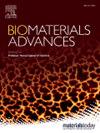Bacteriostatic, silver-doped, zirconia-based thin coatings for temporary fixation devices tuning stem cells' expression of adhesion-relevant genes and proteins
IF 5.5
2区 医学
Q2 MATERIALS SCIENCE, BIOMATERIALS
Materials Science & Engineering C-Materials for Biological Applications
Pub Date : 2025-05-27
DOI:10.1016/j.bioadv.2025.214360
引用次数: 0
Abstract
Temporary fixation devices must support bone healing, be easily removed without bone tissue overgrowth, and reduce the risk of infection. To match these needs, mechanically and chemically stable thin coatings, based on a zirconia matrix doped with silver (ZrO2-Ag), were sputtered on Ti6Al4V. Coatings with two silver concentrations were produced: a low (0.2 % at Ag) concentration (AL) for bacteriostatic effect and a high (0.5 % at Ag) concentration (AH) for antibacterial properties. Surfaces were characterized for silver content and release, mechanical adhesion, morphology, roughness, wettability, and surface zeta potential, reporting high stability and a continuous Ag release over 28 days. Direct cytocompatibility was shown for human mesenchymal stem cells (hMSC), while antibacterial properties were verified towards Staphylococcus aureus. Results revealed non-toxic and anti-adhesion effects of AL that were deeply investigated towards hMSC by a multi-omics approach. Transcriptomics revealed a down-regulation of cadherins- and integrins-related genes involved in the cell-to-cell and cell-to-substrate adhesion, whereas proteomics confirmed a reduced expression of adhesion proteins (Talin and Ras homolog family member A - RhoA). The OMICS profiles were matched by bioinformatics analysis, confirming a cluster of preserved biological functions strongly related to the cells' adhesion but not to apoptosis. Therefore, AL is a good candidate for bone temporary fixation devices, not interfering with bone healing (cytocompatible), avoiding bone adhesion on the implant surface, and being bacteriostatic.
用于临时固定装置的抑菌、掺银、锆基薄涂层调节干细胞粘附相关基因和蛋白的表达
临时固定装置必须支持骨愈合,易于移除而不会导致骨组织过度生长,并降低感染的风险。为了满足这些需求,在Ti6Al4V上溅射了基于掺杂银(ZrO2-Ag)的氧化锆基体的机械和化学稳定的薄涂层。制备了两种银浓度的涂层:低银浓度(银浓度为0.2%)具有抑菌效果,高银浓度(银浓度为0.5%)具有抗菌性能。表面表征银含量和释放,机械附着力,形貌,粗糙度,润湿性和表面zeta电位,报告高稳定性和连续银释放超过28天。对人间充质干细胞(hMSC)具有直接的细胞相容性,对金黄色葡萄球菌具有抗菌作用。结果显示,AL对hMSC的无毒和抗粘附作用被多组学方法深入研究。转录组学揭示了参与细胞与细胞和细胞与底物粘附的钙粘蛋白和整合素相关基因的下调,而蛋白质组学证实了粘附蛋白(Talin和Ras同源家族成员a - RhoA)的表达减少。生物信息学分析与组学图谱相匹配,证实了一组保存的生物功能与细胞粘附密切相关,而与细胞凋亡无关。因此,AL是骨临时固定装置的良好候选材料,不干扰骨愈合(细胞相容性),避免骨粘附在种植体表面,并且具有抑菌作用。
本文章由计算机程序翻译,如有差异,请以英文原文为准。
求助全文
约1分钟内获得全文
求助全文
来源期刊
CiteScore
17.80
自引率
0.00%
发文量
501
审稿时长
27 days
期刊介绍:
Biomaterials Advances, previously known as Materials Science and Engineering: C-Materials for Biological Applications (P-ISSN: 0928-4931, E-ISSN: 1873-0191). Includes topics at the interface of the biomedical sciences and materials engineering. These topics include:
• Bioinspired and biomimetic materials for medical applications
• Materials of biological origin for medical applications
• Materials for "active" medical applications
• Self-assembling and self-healing materials for medical applications
• "Smart" (i.e., stimulus-response) materials for medical applications
• Ceramic, metallic, polymeric, and composite materials for medical applications
• Materials for in vivo sensing
• Materials for in vivo imaging
• Materials for delivery of pharmacologic agents and vaccines
• Novel approaches for characterizing and modeling materials for medical applications
Manuscripts on biological topics without a materials science component, or manuscripts on materials science without biological applications, will not be considered for publication in Materials Science and Engineering C. New submissions are first assessed for language, scope and originality (plagiarism check) and can be desk rejected before review if they need English language improvements, are out of scope or present excessive duplication with published sources.
Biomaterials Advances sits within Elsevier''s biomaterials science portfolio alongside Biomaterials, Materials Today Bio and Biomaterials and Biosystems. As part of the broader Materials Today family, Biomaterials Advances offers authors rigorous peer review, rapid decisions, and high visibility. We look forward to receiving your submissions!

 求助内容:
求助内容: 应助结果提醒方式:
应助结果提醒方式:


